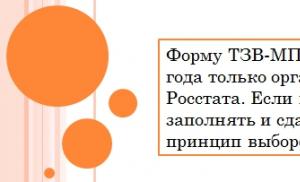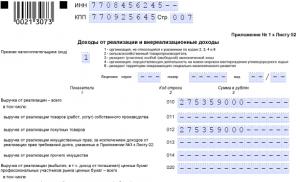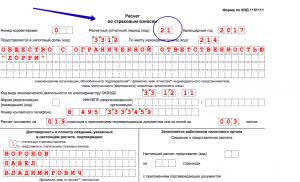Types of subordinate clauses. Main types of subordinate clauses Explanatory circumstances
Connecting subordinate clauses contain an additional message about the proposal expressed in the main part.
An additional message may include an explanation, an assessment of the message given in the main part, a conclusion from it, or additional remarks related to the content of this message, and in the main part of the sentence there are no formal grammatical features indicating that the subordinate clause (beyond with the exception of intonational incompleteness), i.e., it does not need a subordinate part, but the subordinate clause is clearly dependent, since it has a formal indicator of subordination - a union word, and its meaning without the main part is indefinite. This allied word, as it were, contains the content of the previous main part (in whole or in part). In a complex sentence
One of the main benefits of hunting, my dear readers, is that it makes you constantly move from place to place, what very nice for an unemployed person(T.)
the first subordinate clause attached by the union "what", - explanatory, its necessity is due to the structure of the main part of the sentence (the correlative word in that requires specification). The construction of the explanatory clause is such that it does not necessitate a new clause following it, and the latter has the character of an additional remark about the main statement (assessment of its content). This is the connecting part. The nature of its syntactic relations with the preceding part of the sentence resembles the relationship between the parts of a compound sentence, as evidenced by the possibility of replacing the allied word "what" combination "and this" (cf.: And this is very pleasant for an unemployed person), which is unacceptable in a subordinate explanatory clause.
Subordinating-attaching relations are expressed using allied words "what" (in various forms), "where", "where", "whence", "when", "why", "why", "what for", "how".
The allied word is most often used in the joining function "what" (in various forms):
Maxim, shaking his head, muttered something and surrounded himself with particularly thick clouds of smoke, what was a sign of intensified work of thought(Kor.);
He built a house according to his own plan, started a cloth factory, arranged incomes and began to consider himself the smartest man in the whole neighborhood, what and the neighbors did not rebuke him ...(P.);
... She is a fox trail(wolf) mistook for a dog and sometimes even lost her way, what never happened to her when she was young(Ch.).
allied words "why", "why", "why" attach sentences with causal and target shades of meanings:
The goose took another rope in its beak and pulled it, from what immediately there was a deafening shot(Ch.);
My brother had to pass the entrance exams to the institute, why he came to the city;
It was getting dark in the forest why and had to return home.
The least common in subordinate clauses are allied words "where", "where", "whence", "when" and union "how", introducing shades corresponding to their lexical meaning: spatial, temporal, comparative. Moreover, their connecting function is revealed only in combination with the following "And" (“where and”, “when and”, “how and”). For example:
He returned home at exactly five o'clock, when and should have come;
...The truth was that he had indeed fainted, like confessed later(Dost.);
Weak from loss of blood, Benny fell on the battlefield, where and was found unconscious(Lesk.).
Connecting clauses, as a rule, are located after the main part or less often - in the middle. Allowable in some cases, placing them at the beginning of the sentence creates the character of inversion:
Whatoften happens in Indian summer, in the morning the overcast sky began to cheer up in the afternoon, and the soft sun without shadows illuminated the earth(Fed.).
As a result of frequent use, some connecting constructions have turned into stable turns of a phraseological nature: "which is to be expected"; "Q.E.D"; "with which I congratulate you."
Adverbial clauses
NGN with adverbial clauses- this is a sentence, the subordinate part of which answers questions of circumstances. They join the predicate or the entire main part with the help of subordinating conjunctions and allied words.
| Types of adverbial clauses | Questions from the main part to the subordinate | Conjunctions and allied words | Sentence examples |
| 1. Time (indicative words can be in the main part then, always, every time) | When? How long? Since when? How long? | Conjunctions: when, until, barely, only, barely, as soon as, just a little, earlier than, before, since, until, while. | As soon as the December dawn began, Anya went out into the street. Grandfather ordered not to wake Tanya until till won't wake up on its own. As she was leaving the drawing-room, a bell was heard in the hall. As soon as the snow melts in the forest, buds will swell on the birches. |
| 2. Places (indicative words can be in the main part there, there, from where) | Where? Where? Where? | Allied words: where, where, where. | go there where the free mind takes you. ahead, where the grove ended, there were birches. There, where the pines were thinner now, and paths ran in circles across the settled snow. |
| 3. Mode of action (In the main part of the word so, thus. Always come after the main part.) | How? How? | Conjunctions: as, as if, as if, what, in order to. | Pierre waved his hands and head So, as if mosquitoes attacked him. |
| 4. Measures and degrees (In the main part of the word so, so, thus. Join by union is after the main part. They are joined by an allied word before the main part, after it.) | To what extent? In what degree? How much? | Conjunctions: as, as if, as if, exactly that. | Forest on both sides So thick, what nothing could be seen through it. She's lost so much weight what She looked like a sixteen year old girl. Uncle sang like this how the common people sing. |
| Allied words: how much, how much, because. | People were interesting to Samghin so, how much he looked at them and saw himself like them. | ||
| 5. Conditions (have index words then, so, are attached to the entire main part) | Under what condition? | If, if ... then, if, if, as soon as, when (= if), times. | If the sun is not put out, there will always be bunnies. Travel would lose half its meaning if they could not be told. Indeed, if all rainy days to sit still, then, perhaps, you will not go far in the summer. If there are no flowers in the middle of winter, there is no need to be sad about them. |
| 6. Reasons (with unions because, for always come after the main part) | Why? From what? For what reason? | Conjunctions: because, because, because, because, due to the fact that, due to the fact that, due to the fact that, due to the fact that, especially since. | The next day, Prince Andrei went to the Rostovs to dine, because his name was the count. Due to the fact that the trees constantly have to see in front of you, the eye gets tired. Every work is important for ennobles a person. We walked in silence, admiring the steppe, especially since it was becoming more and more attractive. |
| 7. Consequences (indicate the result, always located after the main part) | Because of what? What follows from this? | Union: so. | The rain poured like a bucket, so it was impossible to get out on the porch. |
| 8. Goals | What for? For what purpose? For what? | Conjunctions: so that, in order to, then so that, so that, so that, if only. | I began to imitate a strange sound, to lure the bird. In order to learn to tell the truth to people, one must learn to tell it to oneself. |
| 9. Concessions (indicate the circumstances in spite of which the action takes place) | Despite what? Against what? | Unions: despite the fact that, despite the fact that, although, let, let, for nothing, though. | The night was quiet and bright although there was no moon. Though it was cold, the snow on the collar melted very quickly. Even if the ink has not dried yet, immortality has already been given to words. |
| Allied words: no matter how much, no matter how, no matter where, wherever, whoever, no matter what. | Bonfire, no matter how supported in this misty morning, soon went out. But How many Sasha neither I thought nothing came to his mind. | ||
| 10. Comparisons (attached to the whole main part) | How? Like what? | Conjunctions: as, as if, exactly, as if, like that, like as, as if, than ... the same as ... so. | The forest stands silently like peering somewhere. AND how the fire burned out, topics the moonlit night became more visible. Like a tree sheds its leaves, So I drop sad words. Gerasim grew up dumb and mighty, how the tree grows on fertile soil. |
| 11. Attachments (contain a comment or assessment of what is said in the first part, join the entire main part) | What besides? | Allied words: what, where, where, why, why. | I stay in the country all winter what original and new. I had to go down into the quagmire what it was extremely difficult because of the ice water. |
Attention! Comparative clauses should be distinguished from comparative turns. There is no predicate in comparative phrases. Example: The stars were shining how little suns. How towers, Christmas trees darken. In spangles of frost, exactly in diamonds, dozed off, bowed, birches.
Attention! Mixing the structures of the main and subordinate clauses leads to an error.
Syntactic constructions differ in the number of grammatical
basics. B contains one set of main members, and complex contains two or more. The subordinate part can only be in (SPP). In the design of the NGN, there is always a main part, from which, in most cases, you can ask a question to the dependent one. That is, there is a relationship between them.
The formal sign of a subordinate clause in NGN is the presence of a means of grammatical connection (union or, as well as the impossibility of separation from the main one without loss or distortion of meaning.
Types of subordinate clauses
There are four types of dependent clauses in NGN: adjunctive, attributive, explanatory, and adverbial.
NGN with adverbial clauses is the most difficult type of complex sentences to learn.

This group of dependent parts is heterogeneous in its composition. The questions asked from the main part to the adverbial clause are exactly the same as those of the eponymous minor member of the sentence.
10 varieties of adverbial clauses
- Action pattern.
The adverbial clause of this type answers the questions: "How?", "In what way?"
The summer days passed by so quickly that we involuntarily accelerated along with them.
- Degrees and measures.
To dependent sentences in this case, you can ask questions: "To what extent?" "To what extent?", "To what extent?"
Kashtanov lied so convincingly that everyone believed his stories.
- Time.
As the name implies, such a subordinate adverbial clause indicates the moment of the event. Their typical questions are: "When?", "How long?", "Since when?"
When morning came, the camp town began to revitalize.
- Places.
This type of subordinate clause often refers to one predicate in the main part, less often to the entire sentence. "Where?", "From where?", "Where?" - the main questions of this type.
From where we are going, it will be problematic to return on foot.
- Goals.
In NGN, the adverbial clause reflects the specification of the action taking place in the main clause in terms of the final result. In other words, the design answers the question: "Why?"
To become strong, you need to train hard.

- Conditions and concessions.
Dependent sentences of these types are similar to each other in that in both cases the adverbial meaning is conditioned by something: the action occurs "thanks" or "despite".
If you find time, come visit.
Although the sun had long since set, the heat did not subside.
- Comparisons.
In NGN with an adverbial clause of comparison, such a dependent part explains the content of the main one with the help of conjunctions: "like", "as if", "as if", "exactly".
The ice on the river cracked, as if a huge mirror had cracked.
- Consequences.
Dependent parts denote the result or conclusion from the events taking place in the main sentence. The adverbial adverbial clause of this type is easy to recognize by the unions "so" and "therefore".
The wind howled louder than usual, so I fell asleep only in the morning.
- Causes.
The last type of dependent adverbial parts answers the question: "Why?" Most often, the subordinate clause of the reason is attached to the main one with the help of the unions "because", "because", "because of the fact that" and a number of others.
Maria began to get ready to go home, the first lanterns were lit on the street.
It is worth noting that for definition it is important not only to ask the right question, but also to determine the syntactic means of communication. Often it is the subordinating conjunction that suggests the type of NGN.
Subordinate clauses in Russian are dependent parts of the main clause in a complex sentence. That is, they play the role of secondary members of the sentence. Therefore, the types of subordinate clauses are divided according to the role played in the sentence. One question can be asked to the entire secondary sentence, just as it is done with respect to the members of the sentence.
The main types of subordinate clauses
Four types of them are considered: attributive, adverbial, explanatory and connecting. Examples can be given that will represent all kinds of subordinate clauses:
- The flower bed, which was laid out in the courtyard on the left side of the porch, resembled a small copy of the town - a sort of Flower Town from Nosov's fairy tale about Dunno. (Determinative).
- And it seemed to me that restless and funny short men really live there. (explanatory).
- And we do not see them because they are hiding from us underground. (Circumstantial).
- But as soon as we leave somewhere, as shorties get out of their hiding places and begin to enjoy life violently. (Connective).

Determinative clauses
These subordinate clauses in Russian define the sign of one noun or sometimes a phrase consisting of a noun and a demonstrative word. They serve as answers to questions which? whose? which the? These minor sentences are joined to the main part by allied words. whose, which, who, what, which, from where, where, when. Usually in the main part of a complex sentence there are demonstrative words such as such, each, any, any or that in various forms of childbirth. The following suggestions can be taken as examples:
- living beings, which?) who live on the planet next to people, feel a good human attitude towards them.
- Reach out your hand with food, open your palm, freeze, and some bird, ( which?) whose voice is heard in the morning in the bushes of your garden, with confidence will sit on your hand.
- Every person ( which?) who considers himself the pinnacle of the creation of the Almighty, should correspond to this rank.
- Whether a garden, a forest or an ordinary yard, (which?)where everything is familiar and familiar, can open the door to the wonderful world of nature for a person.

Adventitious connecting
Interesting types of subordinate clauses that do not refer to a single word or phrase, but to the entire main part. They are called connecting. Often these parts of a complex sentence contain the meaning of the consequence, supplementing or explaining the content of the main part. Secondary sentences of this type are attached using allied words where, how, when, why, where, what. Examples:
- And only next to the mother any baby feels protected, what is meant by nature.
- Caring for the cubs, tenderness for their offspring, self-sacrifice is laid in the creature at the level of instinct, how every creature needs to breathe, sleep, eat and drink.

Explanatory clauses
If the author of the text wants to clarify, specify any one word of the main part, which has the meaning of thought, perception, feeling or speech. Often these clauses refer to verbs such as say, answer, think, feel, be proud, hear. But they can also specify adjectives, for example, satisfied or glad. It is often observed when these types of subordinate clauses act as explanations of adverbs ( clearly, necessary, necessary, known, pity) or nouns ( message, thought, statement, rumor, thought, sensation). The subordinate explanatory clauses are added with the help of:
Unions (to, what, when, as if, like others);
Any allied words;
Particles (union) whether.
Examples are the following compound sentences:
- Have you ever observed what?) how amazingly sunlight plays, reflected in dew drops, insect wings, snowflake tiles?
- Once such beauty, a person will surely be incredibly happy, ( what?) who discovered the unique world of beauty.
- And it immediately becomes clear what?) that everything around was created not just so that everything is interconnected.
- Consciousness will be filled with indescribable feelings of joy, (what kind?) as if you yourself are a part of this amazing and unique world.

Adventitious mode of action and degree
Adverbial clauses are divided into several subspecies. A group of dependent parts of compound sentences that refer to a sign or action, called in its main part, and denote its degree or measure, as well as the image, are referred to as subordinate modes of action and degree. They usually answer the following questions: how? how much? as? in what degree? The design of the connection of the subordinate with the main part looks something like this: full adjective + noun + such; full adjective + such; verb + so. The attachment of these subordinate clauses is provided by unions to, what, as if or allied words how much, how much and some others. Examples:
- The little girl laughed so infectiously, so spontaneously, that it was hard for everyone else to stop smiling.
- The sonorous play of her laughter broke the tense silence of the room, as if unexpectedly scattered colorful peas from the package.
- And the little face itself has changed so much, as far as it was possible in this case: the girl, exhausted by the disease, could already easily be called a lovely and absolutely healthy child.

Adverbial clauses
These dependent clauses indicate the place of origin of the action, which is called in the main part of the compound sentence. Referring to the whole main sentence, they answer the following questions: where? where? where? and join with allied words where, from where, where. Often in the main sentence there are demonstrative words there, everywhere, there, everywhere, everywhere and some others. The following examples of such proposals can be given:
- It is quite easy to determine the cardinal directions in the forest more often, where there is moss on the trees.
- Ants dragged on their backs building material for their anthills and food supplies from everywhere, where only these hardworking creatures could get.
- I'm always drawn there, to magical lands, where we went with him last summer.

Adverbial clauses of time
Indicating the time of action, these subordinate clauses refer both to the entire main clause, and specifically to one predicate. For this type of adjective, you can ask the following questions: how long? How long? when? since when? Often there are demonstrative words in the main part of the sentence, for example: sometimes, once, always, now, then. For example: Animals will then be friendly with each other, (when?) when they grow up next to childhood.

Adverbial clauses, causes, purposes, consequences
- If the dependent parts of complex sentences answer questions in what case? or under what condition? and refer either to the predicate of the main part, or to it all, joining with the help of conditional conjunctions once, when, when, if, when And how(in the meaning of "if"), then they can be attributed to subordinate conditions. Example: And even the most inveterate prankster turns into a serious and well-mannered gentleman, ( in which case?)when he becomes a parent, be it a man, a monkey or a penguin.
- Questions because of which? why? for what reason? from what? subordinate causes are responsible. Their attachment occurs with the help of causal unions because, because, since. Example: For a baby in early childhood, the authority of the parent is adamant, ( why?) because his well-being depends on this being.
- Dependent sentences denoting the purpose of the action named in the main part and answering questions for what? for what purpose? why?, are called subordinate targets. Their attachment to the main part is provided by target unions in order to, then in order to (in order to). Example: But even then you should accompany your requirements with explanations ( for what purpose?) then, so that a thinking person grows out of a baby, and not a weak-willed robot performer.
- Dependent parts of a sentence that indicate a conclusion or result, denote a consequence following from the above in the main part of the sentence, are called subordinate consequences and refer to the entire main sentence. They are usually joined by coercive unions. that's why or so, for example: Education is a complex and regular process, ( what follows from this?) therefore, parents should always be in shape and not relax for a minute.

Adverbial clauses
These types of dependent sentences in complex structures refer either to the predicate or to the entire main part and answer the question like?, joining with comparative conjunctions as if, as, as, as, exactly. Comparative clauses differ from comparative phrases in that they have a grammatical basis. For example: The polar bear cub so funny fell on its side and lifted its paws up, it's like a naughty boy playing happily in the sandbox with his friends.

Adverbial clauses
Dependent sentences in a compound construction, denoting circumstances in spite of which the action indicated in the main part has been committed or can be committed, are called subordinate concessions. You can ask them questions: despite what? in spite of what? and attach to the main one with the help of concessive unions at least (although), let (let) that, for nothing, despite and some others. Allied combinations are often used: no matter how much, no matter what, when no, no matter who, no matter how and the like. Example: Even though the panda cubs were having fun, their dark spots around the eyes gave the impression of sad thoughtfulness.
A literate person should always remember: when writing sentences that are part of a complex one, they are separated by commas.
2.2. Complex sentence. Subclauses that refer to one word in the main clause
1. Questions: subordinate explanatory clauses answer the questions of the complement, that is, questions of indirect cases.
2. Main word: subordinate explanatory clauses spread the main word in the main, in need of clarification and expressed verb, noun, adjective, adverb.
3. Communication means: subordinate explanatory clauses can be attached to the main clause with:
- unions (what, to, as, as if, as if), whether union-particles ;
- allied words (who, what, which, which, whose, where, where, from where, when, why, why and etc.).
The main clause may contain (but does not have to) index words that perform the complement function.
4. Place in the offer: adverbial clauses usually come after the word they refer to. However, their position before the main word is also possible.
Started from that[why?], that Kolya, out of mischief, took the book from me(Gaidar).
[ch. + dict. next], ( what- union).
Slobodkin had feeling [what?], as if he was frozen in boundless space(Telpugov).
[n.], ( as if- union).
We are vying questioned coachmen[about what?], Are their horses gentle?(Marshak).
[ch. ], ( whether- union-particle).
- Yulia Dmitrievna, head ordered [what?], so you don't go anywhere(Panova).
[ch. ], ( to- union).
Now nobody does not know [what?], where went to the Kursk gardens "nightingale school" (Peskov).
[ch. ], ( where- union. word).
Note!
1) In explanatory clauses, the most diverse means of communication (both conjunctions and allied words), and some of them ( what how) can be both unions and allied words. Therefore, in this case, one must be especially careful when distinguishing between unions and allied words (see section 2, chapter 2, clause 2.1).
2) The conjunction to always has a target meaning, and it can be used in a subordinate clause.
I woke up Pasha[why? for what purpose?], so that he does not fall off the droshky. (A.P. Chekhov)
This union can also be used in the subordinate explanatory clause, but the question from the main clause to the subordinate clause will be different (questions of indirect cases), and the clauses will have the meaning of desirability, possibility, necessity.
Wed: Elizabeth Kievna asked[about what?], so that she herself would be allowed to take him to the big infirmary(A.N. Tolstoy).
3) Comparative conjunctions, as if, as if, can be used in comparative clauses.
There is something trembling, flickering[how? like what?], like an asterisk on the branches tangled(Marshak).
If they are used in subordinate explanatory clauses, then the question of the indirect case is asked from the main word, and the subordinate clause itself contains a message with a hint of uncertainty, presumption.
Wed: They say[what?], as if he took on more than one adjutant duties(Turgenev).
4) Conjunctions and allied words usually appear at the beginning of a subordinate clause. It is by them that it is quite easy to determine the boundary between the main and subordinate clauses. But the particle conjunction li is always in the middle of the explanatory clause.
Therefore, such complex sentences are often confused with non-union complex sentences. In addition, the position of the union-particle should be taken into account when arranging punctuation marks (the comma is not placed before it, but at the beginning of the subordinate clause).











